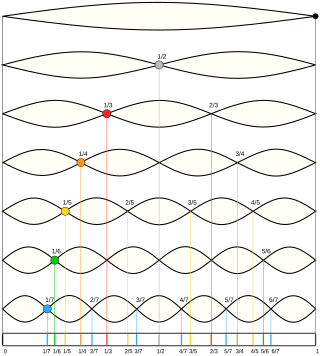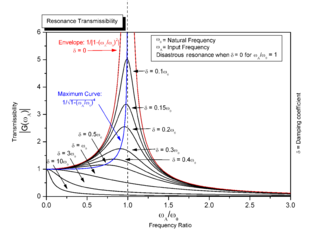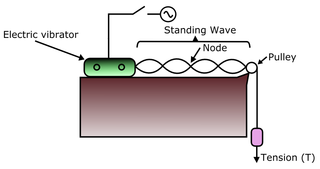
A tuning fork is an acoustic resonator in the form of a two-pronged fork with the prongs (tines) formed from a U-shaped bar of elastic metal. It resonates at a specific constant pitch when set vibrating by striking it against a surface or with an object, and emits a pure musical tone once the high overtones fade out. A tuning fork's pitch depends on the length and mass of the two prongs. They are traditional sources of standard pitch for tuning musical instruments.

In physics, acoustics, and telecommunications, a harmonic is a sinusoidal wave with a frequency that is a positive integer multiple of the fundamental frequency of a periodic signal. The fundamental frequency is also called the 1st harmonic; the other harmonics are known as higher harmonics. As all harmonics are periodic at the fundamental frequency, the sum of harmonics is also periodic at that frequency. The set of harmonics forms a harmonic series.

In physics, resonance refers to a wide class of phenomena that arise as a result of matching temporal or spatial periods of oscillatory objects. For an oscillatory dynamical system driven by a time-varying external force, resonance occurs when the frequency of the external force coincides with the natural frequency of the system. Resonance can occur in various systems, such as mechanical, electrical, or acoustic systems, and it is desirable in certain applications, such as musical instruments or radio receivers. Resonance can also be undesirable, leading to excessive vibrations or even structural failure in some cases.
A phonon is a collective excitation in a periodic, elastic arrangement of atoms or molecules in condensed matter, specifically in solids and some liquids. A type of quasiparticle in physics, a phonon is an excited state in the quantum mechanical quantization of the modes of vibrations for elastic structures of interacting particles. Phonons can be thought of as quantized sound waves, similar to photons as quantized light waves.

The speed of sound is the distance travelled per unit of time by a sound wave as it propagates through an elastic medium. More simply, the speed of sound is how fast vibrations travel. At 20 °C (68 °F), the speed of sound in air is about 343 m/s, or 1 km in 2.91 s or one mile in 4.69 s. It depends strongly on temperature as well as the medium through which a sound wave is propagating. At 0 °C (32 °F), the speed of sound in air is about 331 m/s.
Piano acoustics is the set of physical properties of the piano that affect its sound. It is an area of study within musical acoustics.

Cymatics is a subset of modal vibrational phenomena. The term was coined by Swiss physician Hans Jenny (1904–1972). Typically the surface of a plate, diaphragm, or membrane is vibrated, and regions of maximum and minimum displacement are made visible in a thin coating of particles, paste, or liquid. Different patterns emerge in the excitatory medium depending on the geometry of the plate and the driving frequency.

A normal mode of a dynamical system is a pattern of motion in which all parts of the system move sinusoidally with the same frequency and with a fixed phase relation. The free motion described by the normal modes takes place at fixed frequencies. These fixed frequencies of the normal modes of a system are known as its natural frequencies or resonant frequencies. A physical object, such as a building, bridge, or molecule, has a set of normal modes and their natural frequencies that depend on its structure, materials and boundary conditions.

A vibration in a string is a wave. Resonance causes a vibrating string to produce a sound with constant frequency, i.e. constant pitch. If the length or tension of the string is correctly adjusted, the sound produced is a musical tone. Vibrating strings are the basis of string instruments such as guitars, cellos, and pianos.

A node is a point along a standing wave where the wave has minimum amplitude. For instance, in a vibrating guitar string, the ends of the string are nodes. By changing the position of the end node through frets, the guitarist changes the effective length of the vibrating string and thereby the note played. The opposite of a node is an anti-node, a point where the amplitude of the standing wave is at maximum. These occur midway between the nodes.
Musical acoustics or music acoustics is a multidisciplinary field that combines knowledge from physics, psychophysics, organology, physiology, music theory, ethnomusicology, signal processing and instrument building, among other disciplines. As a branch of acoustics, it is concerned with researching and describing the physics of music – how sounds are employed to make music. Examples of areas of study are the function of musical instruments, the human voice, computer analysis of melody, and in the clinical use of music in music therapy.

Acoustic resonance is a phenomenon in which an acoustic system amplifies sound waves whose frequency matches one of its own natural frequencies of vibration.

Violin acoustics is an area of study within musical acoustics concerned with how the sound of a violin is created as the result of interactions between its many parts. These acoustic qualities are similar to those of other members of the violin family, such as the viola.

Melde's experiment is a scientific experiment carried out in 1859 by the German physicist Franz Melde on the standing waves produced in a tense cable originally set oscillating by a tuning fork, later improved with connection to an electric vibrator. This experiment, "a lecture-room standby", attempted to demonstrate that mechanical waves undergo interference phenomena. In the experiment, mechanical waves traveled in opposite directions form immobile points, called nodes. These waves were called standing waves by Melde since the position of the nodes and loops stayed static.
Sympathetic resonance or sympathetic vibration is a harmonic phenomenon wherein a passive string or vibratory body responds to external vibrations to which it has a harmonic likeness. The classic example is demonstrated with two similarly-tuned tuning forks. When one fork is struck and held near the other, vibrations are induced in the unstruck fork, even though there is no physical contact between them. In similar fashion, strings will respond to the vibrations of a tuning fork when sufficient harmonic relations exist between them. The effect is most noticeable when the two bodies are tuned in unison or an octave apart, as there is the greatest similarity in vibrational frequency. Sympathetic resonance is an example of injection locking occurring between coupled oscillators, in this case coupled through vibrating air. In musical instruments, sympathetic resonance can produce both desirable and undesirable effects.
Speech science refers to the study of production, transmission and perception of speech. Speech science involves anatomy, in particular the anatomy of the oro-facial region and neuroanatomy, physiology, and acoustics.
Ultrasound energy, simply known as ultrasound, is a type of mechanical energy called sound characterized by vibrating or moving particles within a medium. Ultrasound is distinguished by vibrations with a frequency greater than 20,000 Hz, compared to audible sounds that humans typically hear with frequencies between 20 and 20,000 Hz. Ultrasound energy requires matter or a medium with particles to vibrate to conduct or propagate its energy. The energy generally travels through most mediums in the form of a wave in which particles are deformed or displaced by the energy then reestablished after the energy passes. Types of waves include shear, surface, and longitudinal waves with the latter being one of the most common used in biological applications. The characteristics of the traveling ultrasound energy greatly depend on the medium that it is traveling through. While ultrasound waves propagate through a medium, the amplitude of the wave is continually reduced or weakened with the distance it travels. This is known as attenuation and is due to the scattering or deflecting of energy signals as the wave propagates and the conversion of some of the energy to heat energy within the medium. A medium that changes the mechanical energy from the vibrations of the ultrasound energy into thermal or heat energy is called viscoelastic. The properties of ultrasound waves traveling through the medium of biological tissues has been extensively studied in recent years and implemented into many important medical tools.

In physics, sound is a vibration that propagates as an acoustic wave through a transmission medium such as a gas, liquid or solid. In human physiology and psychology, sound is the reception of such waves and their perception by the brain. Only acoustic waves that have frequencies lying between about 20 Hz and 20 kHz, the audio frequency range, elicit an auditory percept in humans. In air at atmospheric pressure, these represent sound waves with wavelengths of 17 meters (56 ft) to 1.7 centimeters (0.67 in). Sound waves above 20 kHz are known as ultrasound and are not audible to humans. Sound waves below 20 Hz are known as infrasound. Different animal species have varying hearing ranges.

Vibration is a mechanical phenomenon whereby oscillations occur about an equilibrium point. Vibration may be deterministic if the oscillations can be characterised precisely, or random if the oscillations can only be analysed statistically.

A wind instrument is a musical instrument that contains some type of resonator in which a column of air is set into vibration by the player blowing into a mouthpiece set at or near the end of the resonator. The pitch of the vibration is determined by the length of the tube and by manual modifications of the effective length of the vibrating column of air. In the case of some wind instruments, sound is produced by blowing through a reed; others require buzzing into a metal mouthpiece, while yet others require the player to blow into a hole at an edge, which splits the air column and creates the sound.













